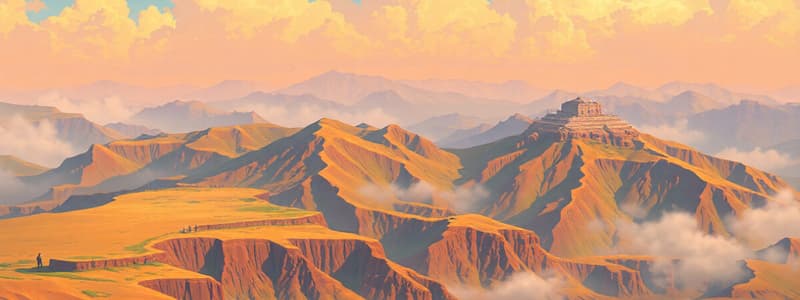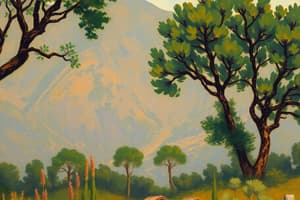Podcast
Questions and Answers
What geological era primarily influenced the topography of Ethiopia?
What geological era primarily influenced the topography of Ethiopia?
- Mesozoic Era
- Paleozoic Era
- Cenozoic Era (correct)
- Quaternary Era
Which feature is described as the highest mountain in Ethiopia?
Which feature is described as the highest mountain in Ethiopia?
- Mount Elgon
- Mount Meru
- Mount Kilimanjaro
- Mount Ras Dashen (correct)
What percentage of Ethiopia's landmass is situated at elevations above 1,500 meters?
What percentage of Ethiopia's landmass is situated at elevations above 1,500 meters?
- 44% (correct)
- 60%
- 30%
- 50%
Which statement accurately describes the Ethiopian Highlands?
Which statement accurately describes the Ethiopian Highlands?
Which physical feature contributes to river dissection and deep gorges in Ethiopia?
Which physical feature contributes to river dissection and deep gorges in Ethiopia?
What is the lowest elevation point in Ethiopia?
What is the lowest elevation point in Ethiopia?
The physiographic divisions of Ethiopia are shaped significantly by which of the following?
The physiographic divisions of Ethiopia are shaped significantly by which of the following?
What is one impact of the relief in Ethiopia on its socioeconomic conditions?
What is one impact of the relief in Ethiopia on its socioeconomic conditions?
What percentage of Ethiopia does the Western highlands and lowlands cover?
What percentage of Ethiopia does the Western highlands and lowlands cover?
What is a characteristic of the Ethiopian highlands?
What is a characteristic of the Ethiopian highlands?
Which of the following features is associated with the Ethiopian lowlands?
Which of the following features is associated with the Ethiopian lowlands?
What natural feature significantly affects the socio-cultural and economic phenomena in Ethiopia?
What natural feature significantly affects the socio-cultural and economic phenomena in Ethiopia?
What is the primary distinction between the highlands and lowlands in Ethiopia?
What is the primary distinction between the highlands and lowlands in Ethiopia?
Which of the following correctly describes the Tigray Plateau in Ethiopia?
Which of the following correctly describes the Tigray Plateau in Ethiopia?
What geological process significantly influences Ethiopian physiographic divisions?
What geological process significantly influences Ethiopian physiographic divisions?
What type of economic life is prevalent in the Ethiopian lowlands?
What type of economic life is prevalent in the Ethiopian lowlands?
What is the height of Guge Mountain, the highest peak in its physiographic subdivision?
What is the height of Guge Mountain, the highest peak in its physiographic subdivision?
Which lowland is characterized by generally arid or semi-arid conditions?
Which lowland is characterized by generally arid or semi-arid conditions?
What percentage of Ethiopia's area is accounted for by the Southeastern Highlands and Lowlands?
What percentage of Ethiopia's area is accounted for by the Southeastern Highlands and Lowlands?
Which of the following towns is NOT located in the Western lowlands?
Which of the following towns is NOT located in the Western lowlands?
Which physio-geographical feature marks the western and northern limits of the Southeastern Highlands and Lowlands?
Which physio-geographical feature marks the western and northern limits of the Southeastern Highlands and Lowlands?
What type of economic activities primarily dominate the Western lowlands?
What type of economic activities primarily dominate the Western lowlands?
How is the Ghibe/Omo lowland classified in terms of its geographical location?
How is the Ghibe/Omo lowland classified in terms of its geographical location?
What is the common elevation range of the Western Lowlands?
What is the common elevation range of the Western Lowlands?
What is a significant barrier to the development of internal transportation in Ethiopia?
What is a significant barrier to the development of internal transportation in Ethiopia?
How does the rugged topography of Ethiopia affect river navigation?
How does the rugged topography of Ethiopia affect river navigation?
What climatic effect is primarily caused by the altitudinal variation in Ethiopia?
What climatic effect is primarily caused by the altitudinal variation in Ethiopia?
What is one of the socio-cultural effects of the rugged terrain in Ethiopia?
What is one of the socio-cultural effects of the rugged terrain in Ethiopia?
Why is there a high potential for hydroelectric power production in Ethiopia?
Why is there a high potential for hydroelectric power production in Ethiopia?
What condition do steep mountain slopes in Ethiopia create regarding soil?
What condition do steep mountain slopes in Ethiopia create regarding soil?
How does relief influence the natural vegetation in Ethiopia?
How does relief influence the natural vegetation in Ethiopia?
What term do people in the highlands use to identify themselves?
What term do people in the highlands use to identify themselves?
What are the prominent features of the Main Ethiopian Rift?
What are the prominent features of the Main Ethiopian Rift?
How does relief impact agricultural practices in Ethiopia?
How does relief impact agricultural practices in Ethiopia?
What is a characteristic feature of the Chew Bahir Rift?
What is a characteristic feature of the Chew Bahir Rift?
In which areas of Ethiopia is animal husbandry influenced by relief?
In which areas of Ethiopia is animal husbandry influenced by relief?
What settlement pattern is typically observed in Ethiopia's highlands?
What settlement pattern is typically observed in Ethiopia's highlands?
How does rugged terrain affect settlements in Ethiopia?
How does rugged terrain affect settlements in Ethiopia?
Which farming practice is most difficult to implement in rugged terrains?
Which farming practice is most difficult to implement in rugged terrains?
What is a unique environmental feature of the lakes region in the Main Ethiopian Rift?
What is a unique environmental feature of the lakes region in the Main Ethiopian Rift?
What percentage of the Southeastern Lowlands area in Ethiopia is made up by the Wabishebelle plain?
What percentage of the Southeastern Lowlands area in Ethiopia is made up by the Wabishebelle plain?
Which of the following commodities is NOT mentioned as having economic potential in the Southeastern Lowlands?
Which of the following commodities is NOT mentioned as having economic potential in the Southeastern Lowlands?
What is the highest point in the region mentioned in the content?
What is the highest point in the region mentioned in the content?
What geographical feature primarily bounds the Rift Valley?
What geographical feature primarily bounds the Rift Valley?
How much of Ethiopia's area does the Rift Valley cover?
How much of Ethiopia's area does the Rift Valley cover?
What is the elevation range on the floor of the Rift Valley?
What is the elevation range on the floor of the Rift Valley?
Which climatic conditions are indicated as existing within the Rift Valley?
Which climatic conditions are indicated as existing within the Rift Valley?
What characterizes the Southeastern Lowlands of Ethiopia?
What characterizes the Southeastern Lowlands of Ethiopia?
Flashcards
Ethiopian Highlands
Ethiopian Highlands
A region in Ethiopia characterized by moderate to high rainfall, lower temperatures, and a higher population density compared to the lowlands.
Ethiopian Lowlands
Ethiopian Lowlands
A region in Ethiopia characterized by less rainfall, higher temperatures, and a lower population density compared to the highlands.
Ethiopian Rift Valley
Ethiopian Rift Valley
A geological feature in Ethiopia formed by the separation of tectonic plates, resulting in a long, narrow valley with steep sides. It's a significant landscape feature in Ethiopia, creating the highlands and lowlands.
Western Highlands and Lowlands
Western Highlands and Lowlands
Signup and view all the flashcards
Tigray Plateau
Tigray Plateau
Signup and view all the flashcards
Western Escarpment of the Rift Valley
Western Escarpment of the Rift Valley
Signup and view all the flashcards
Continental Drift
Continental Drift
Signup and view all the flashcards
What are the Ethiopian Highlands?
What are the Ethiopian Highlands?
Signup and view all the flashcards
What two regions make up the Ethiopian Highlands?
What two regions make up the Ethiopian Highlands?
Signup and view all the flashcards
What are the Southeastern Lowlands?
What are the Southeastern Lowlands?
Signup and view all the flashcards
What two plains make up the Southeastern Lowlands?
What two plains make up the Southeastern Lowlands?
Signup and view all the flashcards
What is the Rift Valley?
What is the Rift Valley?
Signup and view all the flashcards
What does the Rift Valley separate?
What does the Rift Valley separate?
Signup and view all the flashcards
What covers the Rift Valley's floor?
What covers the Rift Valley's floor?
Signup and view all the flashcards
What is the altitude variation in the Rift Valley?
What is the altitude variation in the Rift Valley?
Signup and view all the flashcards
Impact of relief on transportation
Impact of relief on transportation
Signup and view all the flashcards
Cost of infrastructure development
Cost of infrastructure development
Signup and view all the flashcards
Impact of relief on river navigation
Impact of relief on river navigation
Signup and view all the flashcards
Hydroelectric power potential
Hydroelectric power potential
Signup and view all the flashcards
Impact of relief on cultural diversity
Impact of relief on cultural diversity
Signup and view all the flashcards
Local identity influenced by relief
Local identity influenced by relief
Signup and view all the flashcards
Impact of relief on climate
Impact of relief on climate
Signup and view all the flashcards
Impact of relief on soil
Impact of relief on soil
Signup and view all the flashcards
Guge Mountain
Guge Mountain
Signup and view all the flashcards
Western Lowlands of Ethiopia
Western Lowlands of Ethiopia
Signup and view all the flashcards
Subdivisions of the Western Lowlands
Subdivisions of the Western Lowlands
Signup and view all the flashcards
Climate and Activities in the Western Lowlands
Climate and Activities in the Western Lowlands
Signup and view all the flashcards
Irrigation Potential in the Western Lowlands
Irrigation Potential in the Western Lowlands
Signup and view all the flashcards
Ghibe/Omo Lowland: Structure and Location
Ghibe/Omo Lowland: Structure and Location
Signup and view all the flashcards
Towns in the Western Lowlands
Towns in the Western Lowlands
Signup and view all the flashcards
Main Ethiopian Rift - Northern Section
Main Ethiopian Rift - Northern Section
Signup and view all the flashcards
Chew Bahir Rift
Chew Bahir Rift
Signup and view all the flashcards
Ethiopian Rift Valley - Farm Sizes
Ethiopian Rift Valley - Farm Sizes
Signup and view all the flashcards
Ethiopian Rift Valley - Farming Techniques
Ethiopian Rift Valley - Farming Techniques
Signup and view all the flashcards
Ethiopian Rift Valley - Crop Altitudes
Ethiopian Rift Valley - Crop Altitudes
Signup and view all the flashcards
Ethiopian Rift Valley - Animal Husbandry
Ethiopian Rift Valley - Animal Husbandry
Signup and view all the flashcards
Ethiopian Highlands - Settlement Density
Ethiopian Highlands - Settlement Density
Signup and view all the flashcards
Ethiopian Rift Valley - Settlement Patterns
Ethiopian Rift Valley - Settlement Patterns
Signup and view all the flashcards
Describe the Ethiopian landscape.
Describe the Ethiopian landscape.
Signup and view all the flashcards
How are the Ethiopian Highlands divided?
How are the Ethiopian Highlands divided?
Signup and view all the flashcards
What geological processes have impacted the Ethiopian Highlands?
What geological processes have impacted the Ethiopian Highlands?
Signup and view all the flashcards
What is the role of faulting in Ethiopia's landscape?
What is the role of faulting in Ethiopia's landscape?
Signup and view all the flashcards
What other geographical features are formed by faulting?
What other geographical features are formed by faulting?
Signup and view all the flashcards
What are the geomorphic processes that have shaped Ethiopia's landscape?
What are the geomorphic processes that have shaped Ethiopia's landscape?
Signup and view all the flashcards
What are the impacts of Ethiopia's topography on its natural and human systems?
What are the impacts of Ethiopia's topography on its natural and human systems?
Signup and view all the flashcards




